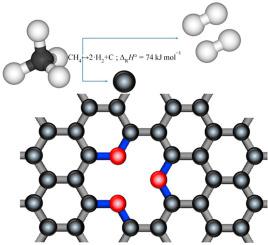International Journal of Hydrogen Energy ( IF 8.1 ) Pub Date : 2021-08-20 , DOI: 10.1016/j.ijhydene.2021.07.234 Alberto Boretti 1

|
In addition to “green” hydrogen from electrolysis of the water molecule with solar-photovoltaic or wind electricity, and “white” hydrogen, based on solar-thermal driven thermochemical splitting of the water molecule, there is another emerging opportunity to produce CO2 free hydrogen at a reduced cost. The perspective advocates in favor of “aquamarine” hydrogen, based on the solar-thermal driven thermal decomposition of methane. This pathway has an energy requirement that is much less than white and green hydrogen, and even if based on hydrocarbon fuel, has no direct production of CO2 as a by-product, but rather carbon particles of commercial interest. Catalytic methane decomposition can be based on self-standing/supported metal-based catalysts such as Fe, Ni, Co, and Cu, metal oxide supports such as SiO2, Al2O3, and TiO2, and carbon-based catalysts such as carbon blacks, carbon nanotubes, and activated carbons, the pathway of higher technology readiness level (TRL). Thus, catalytic methane decomposition appears to be a highly promising approach, with undoubtedly many challenges, but also huge opportunities following pathways to be further refined through research and development (R&D).
中文翻译:

从太阳能驱动的甲烷热分解制氢的观点
除了通过太阳能-光伏或风电电解水分子产生的“绿色”氢和基于太阳能热驱动水分子热化学分解的“白色”氢之外,还有另一个新兴的机会来生产不含二氧化碳的氢以更低的成本。该观点主张支持“海蓝宝石”氢,基于太阳能热驱动的甲烷热分解。该途径的能量需求远低于白氢和绿氢,即使基于碳氢化合物燃料,也不会直接产生 CO 2作为副产品,而是产生具有商业价值的碳颗粒。催化甲烷分解可以基于自支撑/负载的金属基催化剂,如 Fe、Ni、Co 和 Cu,金属氧化物载体,如 SiO2、Al 2 O 3和TiO 2,以及碳基催化剂如炭黑、碳纳米管和活性炭,更高技术准备水平(TRL)的途径。因此,催化甲烷分解似乎是一种非常有前途的方法,无疑面临着许多挑战,但也有通过研究和开发 (R&D) 进一步完善途径的巨大机遇。











































 京公网安备 11010802027423号
京公网安备 11010802027423号